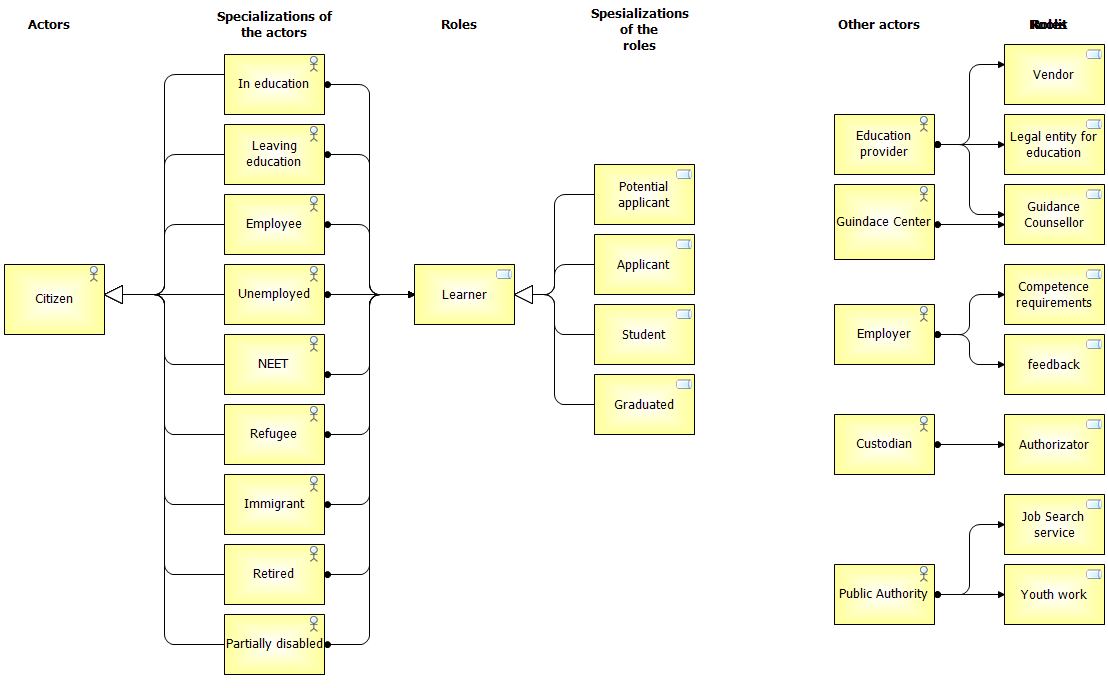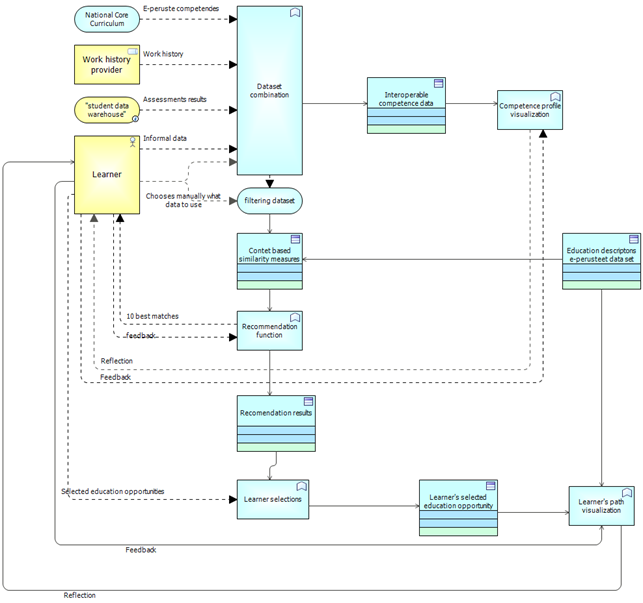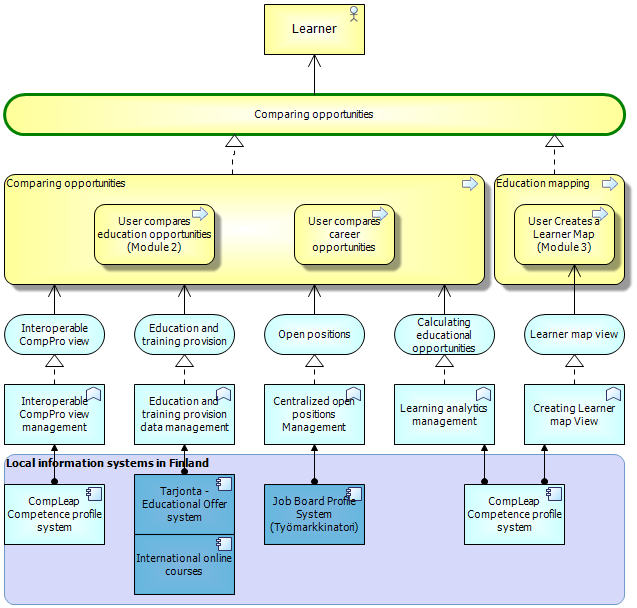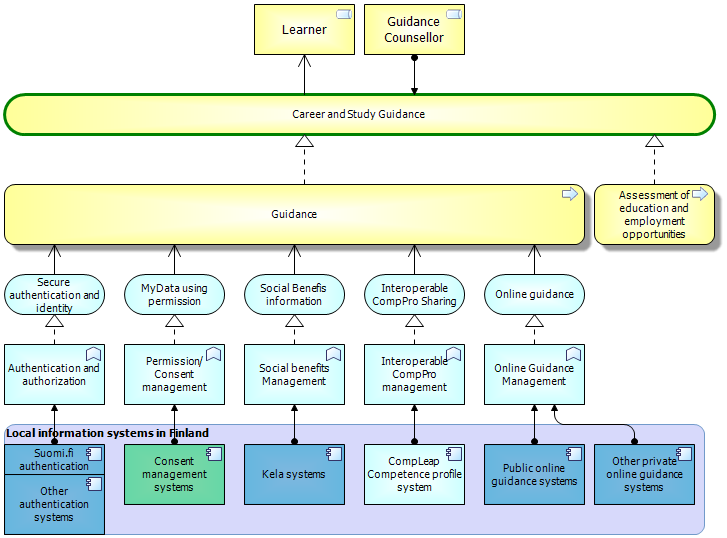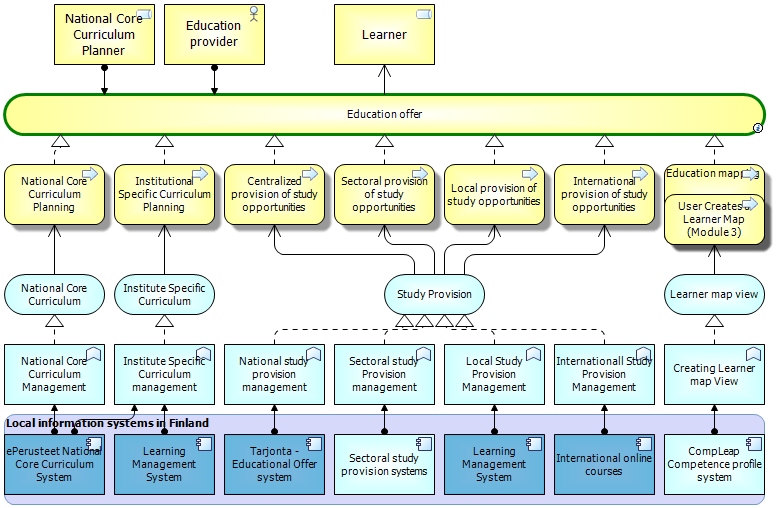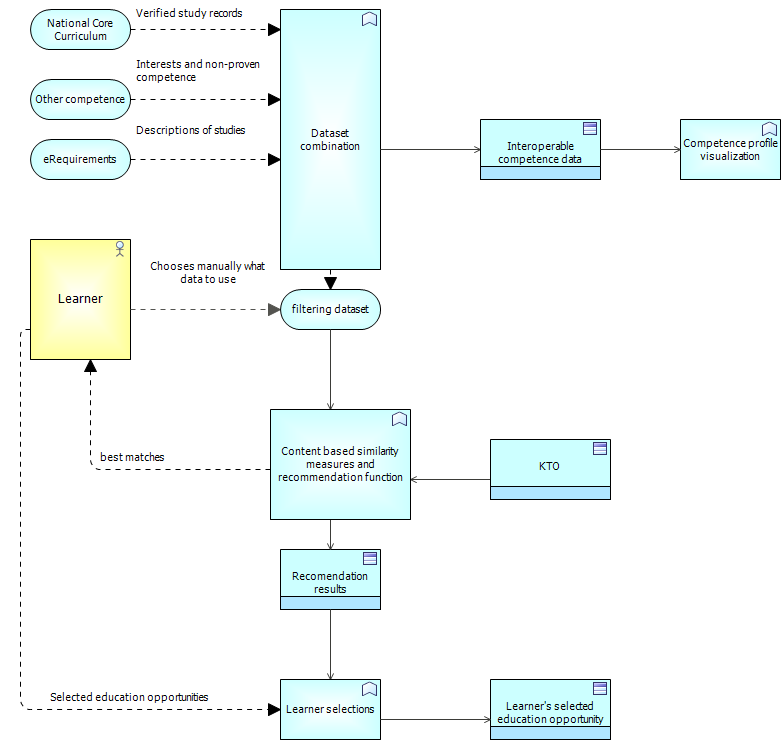Enterprise architecture (EA) is a coherent planning method and a uniform way to describe practices and models for organizations in different stages of the development process. The objective of the EA work is to improve interoperability of activities and services of public administration and private organizations. The main idea of the CompLeap framework architecture can be summarized in this video:
| Widget Connector | ||
|---|---|---|
|
Table of Contents
Below you can find links to the full framework architecture model for the learner-centered service development and learner plan.
Table of Contents type flat
| type | flat |
|---|
...
The learner's pathway can be seen as a value stream which increments learner's competences and, thus, value in some sense. While the value stream is from learner's perspective, the services the learner uses on the path are produced by other actors. The services the learner uses are pinned on the path to tell when the learner is able to use that particular service. By expanding achitecture of the services the framework guides what is needed to implement the services and it is up to a user of the framework architecture to define how the services are actually implemented. To guide in implementation the framework architecture includes an example how this framework is implemented in Finland.
To whom this document is meant for
The document This documentation is meant for decision makers, strategy leaders and developers (education and employment services).
Conventions in the document - Compleap Framework Architecture Meta Model
...
CompLeap Actors and their Roles
The learner's pathway actors and roles are described above. Learner is the center role in the framework architecture and the the learner acts in different specialized roles in the leaner's pathway. The learner can potential applicant, applicant, student or graduated depending on at what stage the learner is in the learner's pathway. Learner can be potentially any citizen of European Union and the citizens are divided into different categories to focus services for them depending on their life situation. From the value stream point of view main actors producing more value to the learner are public authorities, education providers and employers. Education provider offers services to increase learners competencies and employer provides possibility to utilize the competences and turn competences to actual value.
...
The socioeconomic effect in this scope can be thought as a sum of all learner's long term impact in a certain time period. This kind of collective impact can be used to help decision making while planning the national core curriculum or budgeting and funding. The prediction of socioeconomic effect could be possible in similar way as in individual's impact prediction and also simulation would be possible in the same way.
Process Integration
Framework process integration is described above. The diagram shows how data concepts flow between processes.
...
The conceptual data model does not tell how the information is actually structured or modeled. From the framework perspective the concepts are recognized as something which is needed to make data flow smoothly among processes.
Analytics Data flow
Data flow model in the Compleap project illustrates how data flows in the Compleap user services. Information about formal education, previous work history is gathered automatically from other systems and databases. Information about non formal and informal education as well as interests comes from the manual user (learner) input. Specific data set is extracted and used as a data combination to visualize competences for the user and at the same time stimulate his reflection on his current competence situation. User can also manually select data combination and filters to get a education recommendation. This is content based recommendation. 10 best results are presented to the user where he can further select his favorites and proceed to learners path visualization where information about education option is visualized for the user again to promote his understanding of the studying and also self-reflection. User is also able to give feedback about competence and learners path visualizations as well as education recommendations.
...
Purpose of the models: Show processes, application services and information systems needed for providing CompLeap services.
This first diagram illustrates overall process of competence development planning and it's subprocesses in CompLeap referece architecture. The rest of the diagrams in this chapter are subdiagrams that drill deeper into smaller architectural components ("Competence mapping", "Career and Study Guidance", "Comparing opportunities" and "Education offer")
Competence Mapping layered architecture view
...
In CompLeap context the whole competence mapping process is about to be digitalized by module 1 and the process of using digitalized tool is put inside the competence mapping process. In this case, "User creates interoperable competence profile"-process implements the whole competence mapping process but in other implementations there can be manual stages also.
The blue ovals describe the application services supporting the competence mapping process. The application functions are implementations of application services and there could be many application functions which are categorized as same application service. In the diagram only the relevant in the context of the framework are shown.
The lowest row of boxes layer are systems to which the application functions are assigned in Finland. Thus, the system row is implementation specific.
Comparing opportunities layered architecture view
layer is implementation specific.
Comparing opportunities layered architecture view
"Comparing opportunities"-service consists of two subprocesses "Comparing opportunities" and "Education mapping". These subprocesses are devided to smaller processes that are supported by application services (blue ovals) which are implemented by application functions. The lowest layer is country/implementation specific and needs to be replaced with local services.
Career and study guidance layered architecture view
*
This diagram illustrates "Career and Study Guidance"-service and again the types of the layers are similar to what can be found in previous diagram. Again lowest layer is country/implementation specific.
Education offer layered architecture view
This diagram illustrates "Education offer"-service.
Application integration: Case Finland
...
Prototype implements only partial solution of above described reference architecture. Analytics data flow diagram below is modified to describe prototype architecture.
User comes to landing page and either logs in or uses system without logging in. If user logs in and has SSN (HETU) then all user related data is brought automatically from various data sources to dataset combination.
...
